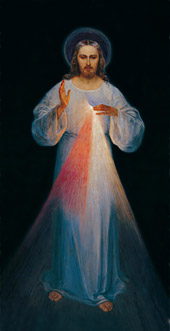Divine Mercy Image
The picture of the Merciful Jesus, often simply called the Divine Mercy image, was painted in 1934 by Eugenijus Kazimirovskis (1873–1939). It presents Jesus as he revealed himself in visions to Sister Faustina, who was a mystic. St Faustina had her first vision in 1931 in the Polish town of Plock. Later she had several more in Vilnius. In his apparitions, the Saviour asked that the vision be painted, and said the painting should include the inscription “Jesus, I trust in you” to remind people that only someone who trusts in God can receive the graces he gives. St Faustina’s spiritual director, Father Michael Sopocko, helped her to do what she was told in the visions.
Jesus showed Himself to Sister Faustina just as portrayed in the painting, which is based on her descriptions. Wearing a white tunic, the Saviour raises his right hand in a blessing motion. He seems to be saying “Peace be with you”, the greeting of Jesus that we hear in the Liturgy of the Word on the Sunday after Easter. The pierced heart (which in the picture is covered by streams of light) and the wounds on his hands and feet all recall the sufferings of Good Friday. The image thus links the two Gospel events that most obviously demonstrate God’s merciful love for us.
With his left hand, Jesus touches the garment near his Most Sacred Heart. From this spot, two rays of light, one white and the other red, gush forth like endless merciful graces. The white ray symbolizes the water that cleanses the soul, the red one – blood, the life of the soul. The Sacraments of Baptism and Penance clean the soul, while the Eucharist vivifies it. The rays therefore speak about the Sacraments and all the graces of the Holy Spirit, the symbol of which is water, and about the New Covenant that God has made with us, which is sealed with the Blood of Christ.
The Merciful Jesus painting was at first kept at the monastery of the Bernardine Sisters near St Michael’s Church, where Father Sopocko was rector. In her diary, Sister Faustina notes that Jesus told her to inform her confessor that the proper place for the painting was in a church, not in the hallway of a monastery. In 1937, on the Sunday after Easter, the current Feast of Divine Mercy, the picture was put on display beside the main altar in St Michael’s Church.
The Soviet authorities, having occupied Lithuania, in 1948 closed St Michael’s Church and destroyed the monastery of the Bernardine Sisters. The painting of the Merciful Jesus remained in the church building until 1951, when two pious women from Vilnius, Bronė Miniotaitė and Janina Rodzevič, bought the canvas from the guard and gave it to the parish priest at the Church of the Holy Spirit for safekeeping. Plans to send the image to Poland failed, and strict Soviet border controls were not the only reason. The person who had agreed to illegally transport the painting changed his mind at the last minute. “It seemed to me that I would have been committing a sacrilege,” he later explained.
In 1956, the Merciful Jesus painting ended up at a small church in the town of Naujoji Rūda, near Grodno. The government later closed that church and seized everything in it, but, miraculously, the painting was left untouched. It was brought secretly to Vilnius in the autumn of 1986 and once more was left at the Church of the Holy Spirit for safekeeping until the new Divine Mercy Shrine was ready. Professional restoration in the spring of 2003 left the image exactly as it was when Eugenijus Kazimirovskis painted it under the direction of Sister Faustina.








